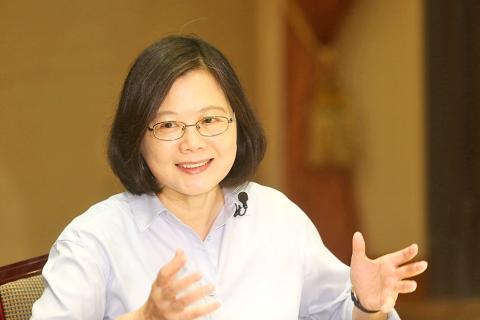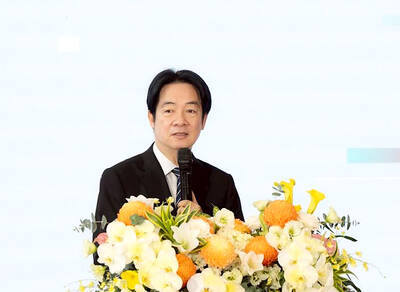President Tsai Ing-wen (蔡英文) has reiterated her proposal that Taipei and Beijing create a new model to handle cross-strait relations, which have been at a standstill since her inauguration in May last year.
Taiwan hopes that both sides can begin to think about the matter after the conclusion of the Chinese Communist Party’s 19th National Congress, at which the party’s new leadership is to be elected, Tsai said in an interview with the Central News Agency published yesterday.
The week-long congress is scheduled to begin on Oct. 18.

Photo: CNA
The two sides of the Taiwan Strait have for many years dealt with their ties based on an established model and guidelines, which to a certain extent have helped maintain cross-strait stability, Tsai said.
However, in view of new international situations, they should consider whether there is a need to examine such old practices and mindsets, she said.
“If we keep sticking to these past practices and ways of thinking, it will probably be very hard for us to deal with the volatile regional situations in Asia,” Tsai said.
Unhappy that Tsai’s government has refused to recognize the so-called “1992 consensus,” Beijing has suspended official dialogue with Taipei since she took office.
The “1992 consensus,” a term former Mainland Affairs Council chairman Su Chi (蘇起) in 2006 admitted making up in 2000, refers to a tacit understanding between the Chinese Nationalist Party (KMT) and the Chinese government that both sides of the Taiwan Strait acknowledge that there is only “one China,” with each side having its own interpretation of what “China” means.
Beijing has insisted that the Tsai administration explicitly accept the “1992 consensus” — which in effect says that Taiwan is part of China — as the political foundation for the continuation of relatively warm relations under her predecessor, former president Ma Ying-jeou (馬英九).
However, Tsai has only been willing to say that she respects the historical fact that cross-strait talks took place and that some understanding was reached.
Both sides have made considerable efforts to maintain cross-strait stability over the past 16 months, Tsai said, but added that on major political issues, “they feel we have not reached their expectations, but we have already shown the utmost goodwill.”
She reiterated that the viewpoints outlined in her inaugural address would remain her principles in dealing with cross-strait ties.
In her inauguration speech, Tsai promised that her administration would work to maintain the existing mechanisms for dialogue and communication across the Taiwan Strait and would conduct cross-strait affairs in accordance with the Republic of China Constitution, the Act Governing Relations Between the People of the Taiwan Area and the Mainland Area (臺灣地區與大陸地區人民關係條例) and other relevant legislation.
She also recognized that “there was joint acknowledgement of setting aside differences to seek common ground” in the 1992 talks between representatives of Taipei and Beijing.
In the interview, Tsai said she did not see Premier William Lai’s (賴清德) comments in open support for Taiwanese independence at the Legislative Yuan on Tuesday last week as affecting cross-strait relations.
Lai is fully aware of the government’s overall policy goals and understands very well “what the limits are,” she said.
Regarding the nation’s military readiness, Tsai said the government would increase its defense spending gradually over the next few years to provide the armed forces with stable financial resources to support efforts to develop a plan to increase the nation’s combat capacity in the next decade.

MISINFORMATION: The generated content tends to adopt China’s official stance, such as ‘Taiwan is currently governed by the Chinese central government,’ the NSB said Five China-developed artificial intelligence (AI) language models exhibit cybersecurity risks and content biases, an inspection conducted by the National Security Bureau (NSB) showed. The five AI tools are: DeepSeek, Doubao (豆包), Yiyan (文心一言), Tongyi (通義千問) and Yuanbao (騰訊元寶), the bureau said, advising people to remain vigilant to protect personal data privacy and corporate business secrets. The NSB said it, in accordance with the National Intelligence Services Act (國家情報工作法), has reviewed international cybersecurity reports and intelligence, and coordinated with the Ministry of Justice Investigation Bureau and the National Police Agency’s Criminal Investigation Bureau to conduct an inspection of China-made AI language

BOOST IN CONFIDENCE: The sale sends a clear message of support for Taiwan and dispels rumors that US President Donald Trump ‘sold out’ the nation, an expert said The US government on Thursday announced a possible sale to Taiwan of fighter jet parts, which was estimated to cost about US$330 million, in a move that an expert said “sends a clear message of support for Taiwan” amid fears that Washington might be wavering in its attitude toward Taipei. It was the first announcement of an arms sale to Taiwan since US President Donald Trump returned to the White House earlier this year. The proposed package includes non-standard components, spare and repair parts, consumables and accessories, as well repair and return support for the F-16, C-130 and Indigenous Defense Fighter aircraft,

CHECKING BOUNDARIES: China wants to disrupt solidarity among democracies and test their red lines, but it is instead pushing nations to become more united, an expert said The US Department of State on Friday expressed deep concern over a Chinese public security agency’s investigation into Legislator Puma Shen (沈伯洋) for “secession.” “China’s actions threaten free speech and erode norms that have underpinned the cross-strait ‘status quo’ for decades,” a US Department of State spokesperson said. The Chongqing Municipal Public Security Bureau late last month listed Shen as “wanted” and launched an investigation into alleged “secession-related” criminal activities, including his founding of the Kuma Academy, a civil defense organization that prepares people for an invasion by China. The spokesperson said that the US was “deeply concerned” about the bureau investigating Shen

‘TROUBLEMAKER’: Most countries believe that it is China — rather than Taiwan — that is undermining regional peace and stability with its coercive tactics, the president said China should restrain itself and refrain from being a troublemaker that sabotages peace and stability in the Indo-Pacific region, President William Lai (賴清德) said yesterday. Lai made the remarks after China Coast Guard vessels sailed into disputed waters off the Senkaku Islands — known as the Diaoyutai Islands (釣魚台) in Taiwan — following a remark Japanese Prime Minister Sanae Takaichi made regarding Taiwan. Takaichi during a parliamentary session on Nov. 7 said that a “Taiwan contingency” involving a Chinese naval blockade could qualify as a “survival-threatening situation” for Japan, and trigger Tokyo’s deployment of its military for defense. Asked about the escalating tensions